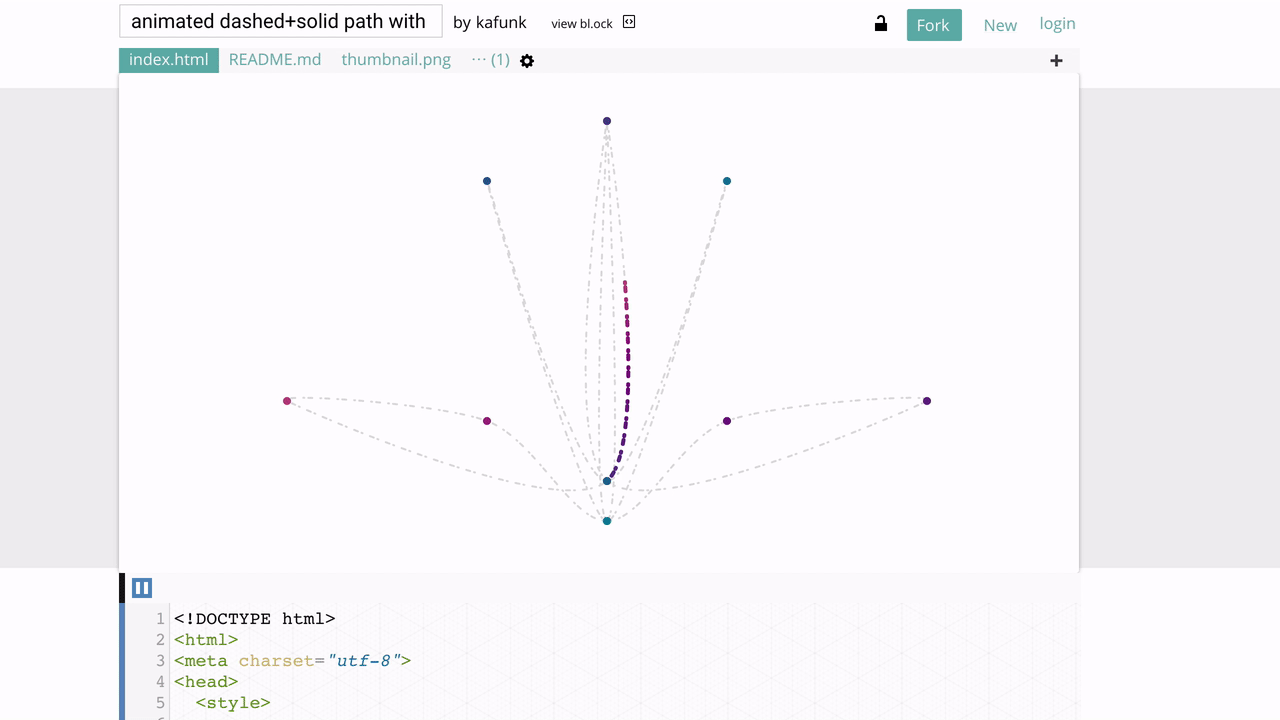What if you could take any random D3 example and wrap it in a React component in just 2 minutes? Wouldn't that be great? 👌
Combining D3 and React can be tricky. D3 loves internal state, React likes components to be stateless. I wrote a whole book about it there's so much nuance.
"Fully controlled components" is the latest buzzword I believe. Rendering depends on props.
D3 likes to set up objects with internal state. You call them and out comes a beautiful picture. A data visualization. A piece of art. Anything really it's very flexible.
Something like this for example 👇
No, I don't know how that example works. And that's the point.
Most people write D3 by looking for examples, copy-pasting some code, and tweaking until it looks right.
But most D3 examples out there are written as one-off pieces of art. With flat JavaScript, old conventions, and code that's not very reusable.
React doesn't like that.
D3 blackbox components
Enter blackbox components: A quick way to wrap any D3 example in a React component.
Here's an old video of mine explaining how that works 👇
The approach works like this:
- Find example you like
- Copy the code
- Wrap it in a render function
- Use a
D3blackboxhigher order component to render an anchor element - Use mount and update hooks to render D3 into the anchor
- React controls the anchor element, D3 controls the insides
This is a quick way to integrate any D3 example in your React code. Fast to set up, easy to work with.
Here's a CodeSandbox from my workshops using the blackbox approach to make a random barchart reusable.
👌
The HOC to make that work is a little scary. Hard to explain too.
export default function D3blackbox(D3render) {return class Blackbox extends React.Component {anchor = React.createRef();componentDidMount() {D3render(this.anchor, this.props, this.state);}componentDidUpdate() {D3render(this.anchor, this.props, this.state);}render() {const { x, y } = this.props;return ;}};}
17 sloc function that returns a class-based component with an anchor, two lifecycle methods, and a rendered `` element. That's our anchor.
Using this HOC looks like wrapping some D3 code in a D3blackbox call.
const Barchart = D3blackbox(function(anchor, props) {var svg = d3.select(anchor.current),// ...
Your D3 code gets the anchor, props, and state. Do what you want.
Hooks make blackboxes easier
That's all fine and good, but we can make it even better with React's new hooks proposal. Hooks are an early RFC, and as of November 2018, this API is still likely to change.
But you can try them out with React 16.7 alpha. Just set your package.json to next.
Using the same idea:
- React controls anchor node
- D3 controls the insides
- Render D3 on all updates
- Wrap D3 in React super fast
Hooks let us achieve all that in just 8 lines of code. Versus the 17 it took with a HOC.
Here's me figuring it out in a ninja livecode session 👇
And here's proof that it takes just 2 minutes to take any random D3 example and wrap it in a React component. Whole video fits in a tweet 👇
https://twitter.com/Swizec/status/1057519327774232576
Here's how it works:
const D3blackbox = ({ x, y, render }) => {const refAnchor = React.useRef(null);React.useEffect(() => {render(d3.select(refAnchor.current));});return ;};
We have a D3blackbox component that takes coordinates and a render method as props. It uses the useRef hook to add a React ref to our functional component and useEffect to automatically call your render method on component mount and update.
It passes a d3.select-ed element into your render method so you can get started with D3 stuff right away.
Then it renders the anchor element as an SVG group.
You use it like this:
// D3 code} />
😍
Caveats
Hooks themselves aren't really ready for realzies quite yet. You can play around, but I don't recommend using in production just yet or rewriting your apps.
React ecosystem sure seems excited though. That genie is never going back in its bottle.
D3 blackbox rendering itself has a few caveats. You're destroying and reconstructing your entire D3 visualization on every update. This can become costly.
Once you take control away from React, its beautiful algorithms and optimizations can't help you.
Quick prototypes and experiments, though, this is perfect 👍🏼
About the Author
Hi, I’m Swizec Teller. I help coders become software engineers.
Story time 👇
React+D3 started as a bet in April 2015. A friend wanted to learn React and challenged me to publish a book. A month later React+D3 launched with 79 pages of hard earned knowledge.
In April 2016 it became React+D3 ES6. 117 pages and growing beyond a single big project it was a huge success. I kept going, started live streaming, and publishing videos on YouTube.
In 2017, after 10 months of work, React + D3v4 became the best book I'd ever written. At 249 pages, many examples, and code to play with it was designed like a step-by-step course. But I felt something was missing.
So in late 2018 I rebuilt the entire thing as React for Data Visualization — a proper video course. Designed for busy people with real lives like you. Over 8 hours of video material, split into chunks no longer than 5 minutes, a bunch of new chapters, and techniques I discovered along the way.
React for Data Visualization is the best way to learn how to build scalable dataviz components your whole team can understand.
Some of my work has been featured in 👇
